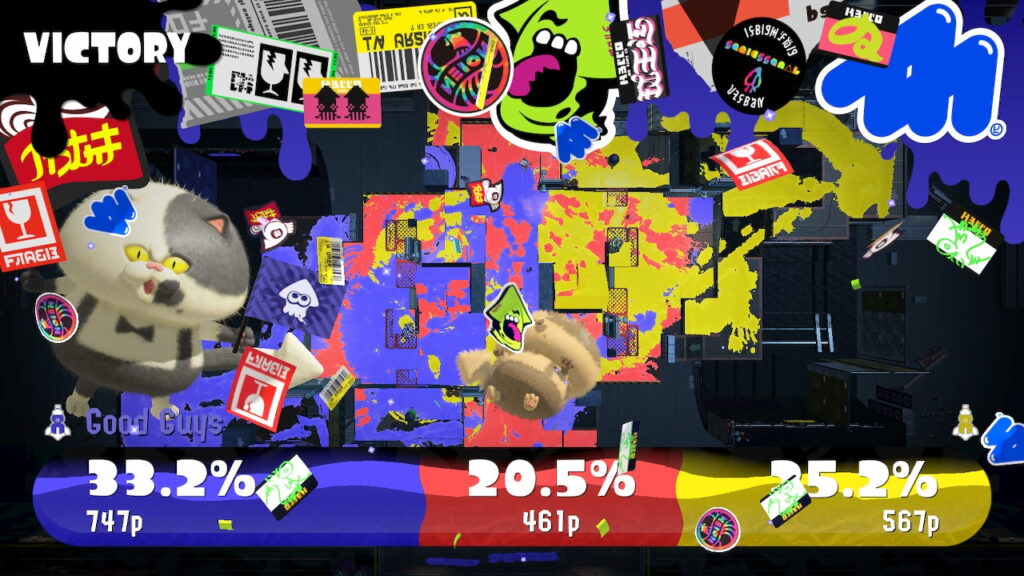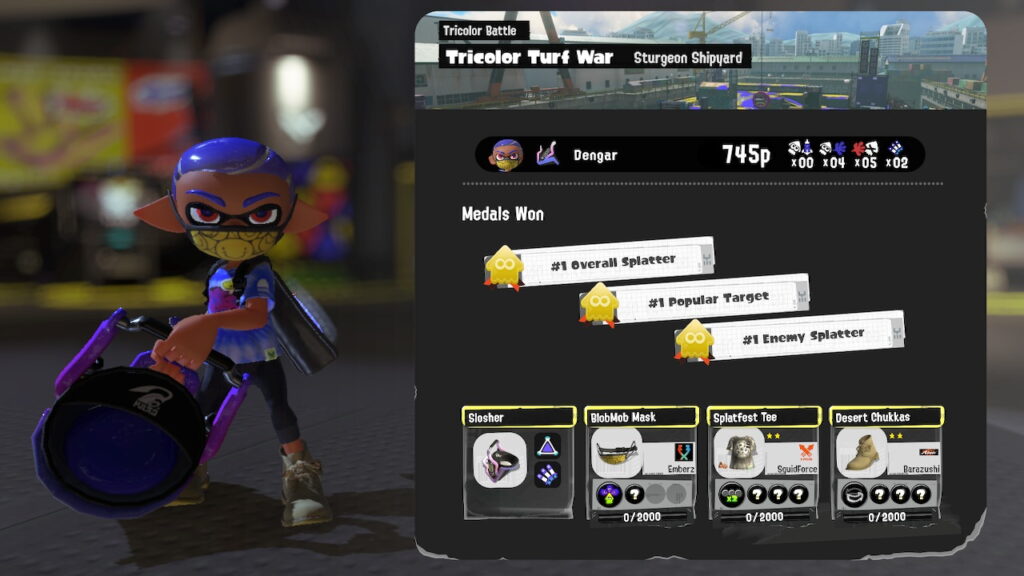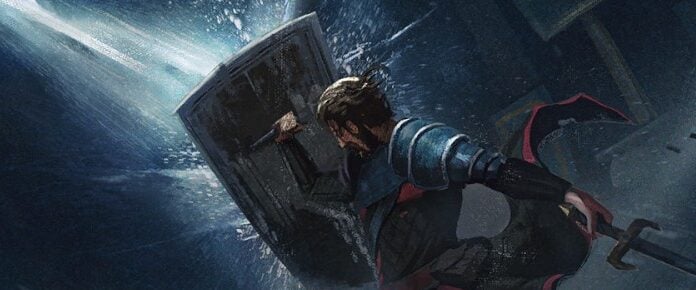
As Splatoon 3‘s release swims ever closer, I keep thinking back to the recent Splatfest demo we had. Splatfests aren’t new to veterans of the series: Nintendo picks a fun “Which is better? A or B?” and then lets people pick a side to fight for in terrain painting wars. Winners get bragging rights and customization tools; losers get, well, fewer of those customization tools. Maybe some sour grapes if they were super invested in the argument.
But the recent demo mixed things up, not only because Splat 3 is bringing new powers and weapons but because Splatfest now has three teams instead of two. In addition, rather than just being the same content all day long, Splatfest has two components: the initial 4v4 between two different groups (for this event, Rock, Paper, or Scissors) and a 4v2v2 halfway through the event. The leading team becomes the “defenders,” and the two other teams, each composed of two people from the two runner-ups, are on the attack. It’s an interesting concept to say the least, but it also can act as a kind of training for ranked matches.
The squids go swimming two by two
Now, the demo didn’t allow for leveling of characters or gear, so the weight of the battles and their outcomes was admittedly missing. As the demo also won’t carry over any stats, I think Nintendo should have turned on leveling just so people (especially new players) could get an idea of how wins and losses will impact the grind. That being said, leaving all leveling out did help focus the demo on the gameplay, and the gameplay itself is pretty good.
The 4v4 battles largely felt as enjoyable as past Splatoon titles have, so I’m going to focus on the 4v2v2 battles. While all the teams’ overall Splatfest scores were even enough that I was able to play both attacker and defender, I found being an attacker in this mode was more enjoyable. Essentially, the overall Splatfest winners are the four people defending the middle of the map, which occasionally spawns an item defenders can’t use but the other two teams can. Nabbing it turns on big sprinklers that give that team some extra paint around the map (which, for the new squids in town, is how you win).
The four defenders don’t really get to do much more than defend. You can see when the Sprinkler can be taken, but it may as well be pointing at a poster. Yes, there is some sense of urgency to prevent its loss, but the lack of interaction with the defense item is noticeable. If you’re really into winning, you probably won’t mind, but the inability to “win back” the target makes defense feel too pass/fail to be constantly enjoyable.
For the other two sides, though, this guarantee makes you hungry for success. You have to attack the sprinkler and get close enough to use it, and that’s where things get messy. While the other two teams are, well, separate teams, they also win/lose together. That gets complicated as they also have friendly fire between them. So if Paper’s winning/defending and Rock is about to take the Sprinklers, Scissors can kill Rock and try to take the Sprinklers for themselves.
It’s classic three-faction PvP, but smaller, instanced, and with far fewer hurt feelings in my opinion. Battles last only a mere three minutes, but level design is tight enough that you can find room to breathe but still fear someone will find you, so there’s never a dull moment.
In a sense, what Splatoon 3 does for faction-based PvP vaguely reminds me of what Monster Hunter does for raiding. While MH distills raiding down to a much more visual (and maybe even punishing) avoid-the-attack-dance while everyone shares at least the tank and DPS roles, Splat3’s Splatfest roughly adapts that formula with the temperature lowered quite a bit, making PvP more palatable in my opinion.
While kills are still important in Splatoon, the series’ emphasis on painting terrain gives non-killers something else to focus on in Turf War, the game’s main multiplayer PvP mode. The 4v2v2 Tricolor Turf War, though, pushes players more toward achieving kills as a method of reaching the map’s main objective. It’s not enough to get a lot of kills; you must do so with purpose. By making the “losing” sides only teams of two, Nintendo forces players on losing sides into a situation where they need to work with one other person.
Yes, I know we have MMO fans who are more into soloing, and for them, these modes won’t be your thing. The 4v4 Turf Wars may still be enjoyable as one person sneaking off to paint while three others distract the other team can actually be a reasonable tactic (and I often suggest the paint brushes and rollers for that). But in the 4v2v2 mode, if you’re trying to solo, your teammate will have to follow you and make the most of your actions. And that’s OK.
Bluntly, this does mean that if someone keeps charging in and dying, it’s going to be frustrating. That being said, forcing a player to rely on another sole teammate means the smarter player has to learn non-verbal queues and patterns to make the best of the situation. It’s a skill most PvPers have had to deal with since the dawn of the genre, but there’s no “out” from looking for other smarter players except on the other “allied” team, which then becomes a lesson in trust.
This will weed out more non-PvPers and people with short tempers, in my opinion, which sadly may make the mode less accessible for the PvE crowd.
There may be some good news, however: The first is that Salmon Run, the PvE mode, is supposed to be always available, so people who like team play but not PvP should still be able to play uninterrupted. For solo-queue PvP folks who just want to paint, the 4v4 option was still available during the 4v2v2 mode’s time period during the demo. If both of these remain true during release, it just means activity options will expand during Splatfest rather than force everyone into the same thing.
For those of us who enjoy team-based PvP, though, the 4v2v2 could be good training. One of the biggest issues I often have in PvP games is the solo queue person who rages against his own team without modifying his playstyle to fit the group. The lack of chat and limitation of pre-set texts does help cut down on this, but solo-queue folks don’t always understand that they may be the problem. By pairing them up with only one other person, the 4v2v2 mode could help players better understand how and when to act as support to other players or lead without getting the other person killed.
For example, let’s say I’m Rock, and Scissors and I are attacking Paper, who’s on the defense. You notice that I get killed a lot by Paper because I go in too deep, or maybe Scissors kills me in the crossfire. With this in mind, one thing you could do is create a lot of paint ahead and around me so I have places to move. Remember, your paint also “heals” and gives a “speed boost.” It can also allow for some pseudo-stealth if I move slowly enough. So if you assume I’m going to go Rambo, you can set up an environment for me to do that but also fire off a few shots for you to hide. Once I’ve been murdered, you can figure out your next move: If I was able to kill or weaken Paper, maybe Scissors is able to move in, so you can pick them off. Or maybe Scissors doesn’t make any headway without me, so you can apply pressure to Paper until I can respawn and jump to you (remember, your teammate can be fast-traveled to!).
As in MH, roles in Splatoon are often shared more broadly than more massive titles, but the ideas and real-life skills often carry over, particularly situational awareness and assessment. In the above situation, maybe you’re the guy running to the front and always dying. Once you realize you’re tilted but getting support, you can try to figure out what your teammate is doing. If you know she’s creating safe spots for you, you can find those more easily. Maybe slow down your zerg a bit, pseudo-stealth through your paint, and pop-up when the enemy least expect it, or simply switch from zerging to hit-and-run tactics. That’s the beauty of the smaller-scale battles. And if you don’t? No big deal, the match is only three minutes long, so just take a break or use what you’ve learned in the next match.
Even better is that being able to figure all that out in a three-faction setting means it’ll be easier to do in a two-faction setting, except you’ll also have a larger team to practice and utilize that situational awareness with. Sure, Splatfest is fun when you can play with non-hardcore friends who just wanna get their paint on. But honestly, it’s also where I’ve found good players to queue with between ‘Fests when I actually want to make headway in ranked play.
Yes, 4v2v2 turf wars can just be chaotic mass-zerging if you want. Queues were going strong up to the very end of the demo, and given that there were no long-term benefits, I suspect the game mode is popular enough with the masses, at least for now, and especially because players had hours to get sick of it and leave if they had chosen to do so. I admittedly missed the first half of the overall test, but I experienced nearly the full duration of the 4v2v2 portion, and I’m excited to see if it will remain at least as enjoyable at launch.
Other pearls of wisdom
The demo also allowed us to see a few other features, though maybe not always in the best way. For example, 10x Battles have returned and are a nice idea, especially with the new Festival Shells, but it was hard to really “get” when the demo turns Splatoon into a ’90s skill-based lobby-shooter instead of the level-based gear-grind many of us queue up for. I know that sounds kind of bad, but c’mon, unlocking skills on great-looking gear while literally painting the town red (or blue, or purple…) is why we’re here.
The 10x Battles are an issue because they’re connected with Clout, a kind of match-making rank that also is used to determine the overall Splatfest winners. Maybe hardcores are more invested in those specific numbers, but I think many people wanted to do something with unlocking gear and abilities, which sadly wasn’t an option. It was nice to win a 10x Battle, but personally, I found the lack of progression robbed it of its impact.
Speaking of impact, for Inkstrike lovers, the new triple version is more balanced but not as fun. While I understand the Splat 1 version, which used the Wii’s screen controller to allow you to drop a huge blast anywhere on the map, might be hard for the Switch to recreate, it was more tactical and palpable. Smart players returned to their base, quickly figured out the best place to strike, and released it like a Starcraft 2 nuclear strike, but without the warning.
The new triple one cannot hit anywhere on the map, doesn’t even feel like a third of the original’s size, and because of its far shorter range is more of a frantic “Use it!” tool than a thinker’s tool. While Inkstrike all but painted a target on your back (like many of the special weapons do), the trade-off felt like relieving some pressure on the enemy team (since users often went back to the base, taking you off the field) in exchange for a single big shot. Splat 3, instead, makes Inkstrike feel a bit like calling in an airstrike, which is still cool but not quite the same.
Video comparison between Splat 1 inkstrike and Splat 3’s makes the blast radius look about the same in terms of size, but perhaps because of the far shorter range of the triple version combined with the frantic need to use, it gives the impression of being less powerful. After all, smart map use made it far easier to Inkstrike to take out a whole team far from the front line in the original Splatoon, and this perhaps may have been perceived as a problem.
Despite all that, the new Inkstrike is still my choice for ultimates thus far, as the Crab Tank just doesn’t cut it for me, and the Reefslider thus far felt like the lateral version of Major Kong’s wild ride, in terms of advertising incoming doom and destruction (though on a far smaller scale, naturally). I’m liking the new Ultimates better than Splat2’s though, which were maybe more balanced, but less fun and less impactful in my opinion.
The new medals are fun too, and I wish I’d had more time to appreciate them, as it felt like the screen flipped past them fairly quickly. As usual, I ended up being the de facto tank throughout Splatfest, not necessarily because I take the most damage (though I do), but because there’s a medal showing Most Popular Target (which is probably inkling for my name because I got it a lot). But hey, it also shows I’m doing my part and that it’s not in my head!
Other medals, such as for painting the most of the enemy base or using the most ink, highlight other aspects of gameplay. It’s a small but fun bonus that helps highlight both your playstyle and your affect on the battlefield, which I find far more useful than “most damage done.” It’ll be fun to see how those medals help reinforce or redirect player habits, especially when combined with the 4v2v2 Tricolor Turf War and ranked gameplay we’ll see at release. My only concern is whether or not the always-on PvE mode will bring enough new players that will allow the Tricolor Turf War to divide the Splatfest playerbase.
Only TWO days left until the Splatoon 3 game releases! We didn’t even need to check with the Quantum Math dept. to confirm. Anyway, Ballistics wants to mention that every main weapon from previous games will be there at launch, including dualies and rollers with vertical swings. pic.twitter.com/ZFVegd0wFq
— Splatoon North America (@SplatoonNA) September 7, 2022
 Massively OP’s Andrew Ross is an admitted Pokemon geek and expert ARG-watcher. Nobody knows Niantic and Nintendo like he does! His Massively on the Go column covers Pokemon Go as well as other mobile MMOs and augmented reality titles!
Massively OP’s Andrew Ross is an admitted Pokemon geek and expert ARG-watcher. Nobody knows Niantic and Nintendo like he does! His Massively on the Go column covers Pokemon Go as well as other mobile MMOs and augmented reality titles!















